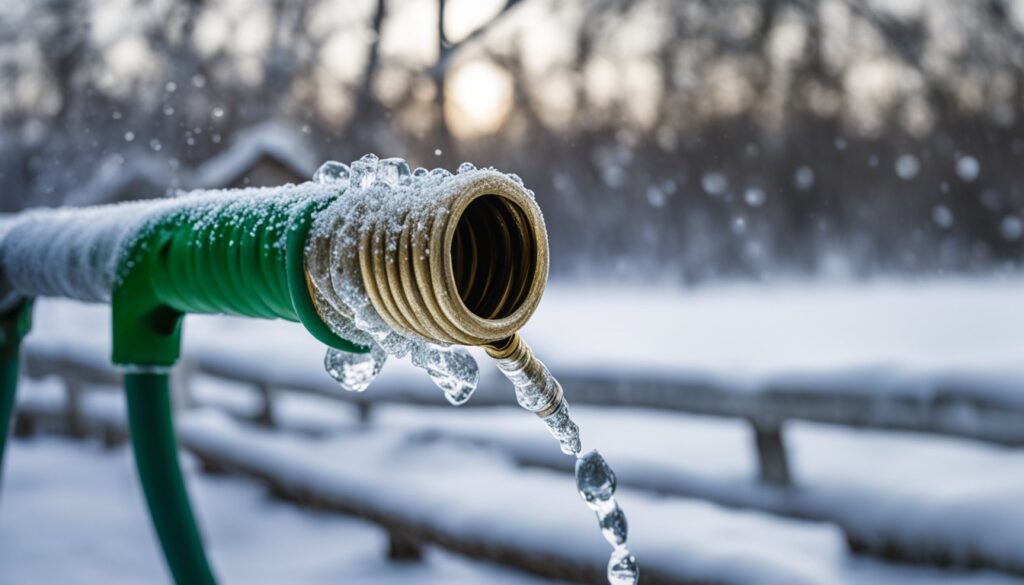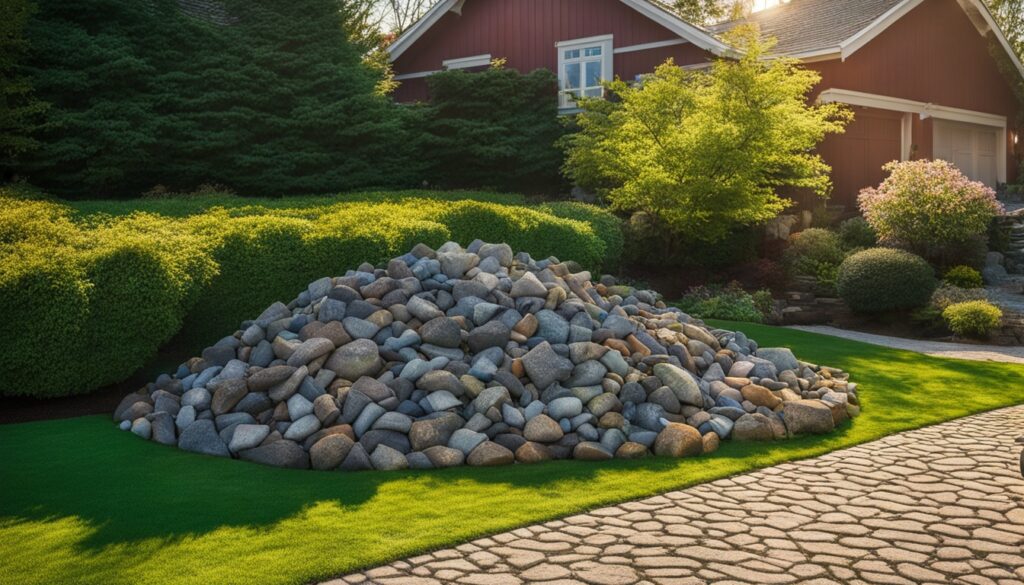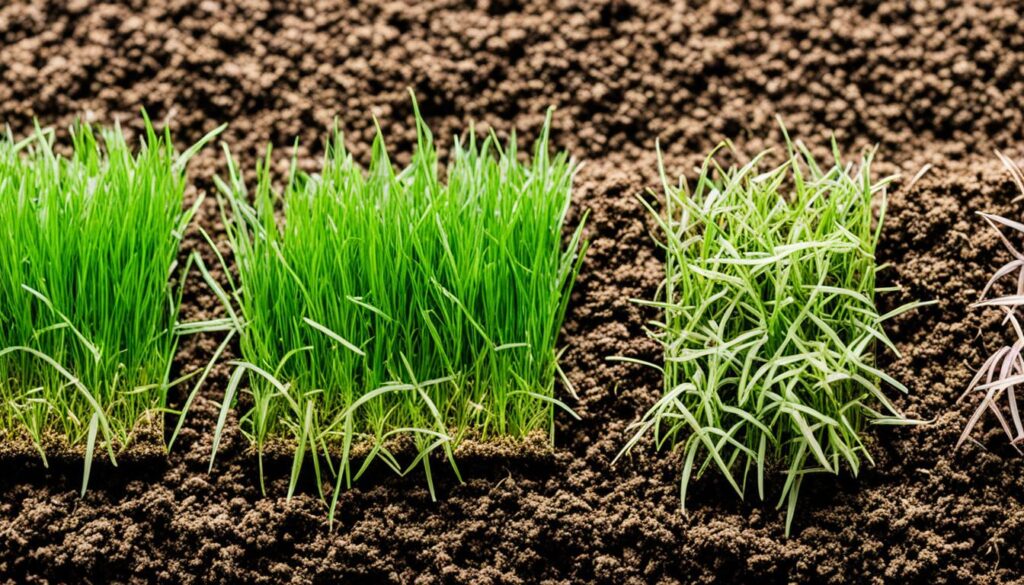Did you know that over 30% of garden hoses get damaged or need replacing every year because of freezing temperatures? Leaving your garden hose out in the cold can lead to burst pipes and expensive repairs. But, constantly hooking up and draining your hose inside can be a big hassle. So, is there a way to keep your hose safe and still use it in the cold?
This article will look into the dangers of leaving hoses outside in winter. We’ll also cover why they freeze and offer ways to prevent damage. Whether you’re an experienced gardener or a new homeowner, knowing how to care for your hoses in winter can save you time and money.
Key Takeaways
- Leaving garden hoses outside in the cold can make them split, burst, or weaken, needing replacement.
- It’s important to store and protect your hoses properly to keep them safe during winter.
- Using heated hoses, heating cables, and insulation can help you use your hose all year without worry.
- Winterizing soaker hoses and draining and disconnecting hoses correctly are key to preventing freeze damage.
- Understanding why hoses freeze can help you make better choices for their care in the cold.
What Happens When Garden Hoses Freeze
When it gets cold, garden hoses can be damaged. The water inside can freeze in just 6 hours if it’s below 32°F (0°C). This freezing makes the hose split, crack, or burst, causing permanent damage.
The Science Behind Garden Hose Freezing
Garden hoses are more likely to freeze because they’re outside. When water inside freezes, it gets bigger and puts pressure on the hose. This pressure can make the hose break, causing leaks and other issues.
Signs of a Frozen Garden Hose
- Stiffness and inability to bend the hose
- Visible ice buildup along the length of the hose
- Reduced or stopped water flow through the hose
If you see these signs, your hose has likely frozen and might be damaged. Fixing it quickly is important to keep it working for next year.
“Freezing temperatures can wreak havoc on garden hoses, causing them to split, crack, and burst. Recognizing the signs of a frozen hose is the first step in protecting your valuable outdoor equipment.”
Why Not Leave Garden Hoses Outside During Winter
Leaving your garden hose outside in winter might seem easy, but it’s not a good idea. The cold weather can cause risks of leaving garden hoses outside in winter. Problems with outdoor garden hoses in cold weather can lead to serious issues. When the temperature goes down, water inside the hose can freeze and cause damage.
This damage might mean you’ll need a new hose soon after winter ends. Even if you use the hose often, bringing it inside every time can be a big hassle. The ease of leaving it outside doesn’t outweigh the damage and hassle from frozen hoses.
“Freezing weather can quickly take a toll on garden hoses left outside during the winter. Excess water trapped in the hose can freeze, causing it to split, burst, or weaken over time.”
It’s best to keep your garden hose inside when it’s cold. But, if you use it a lot, this might not be possible. Looking into heated garden hoses or insulation can help protect your hose and make it last longer.
The risks of leaving garden hoses outside in winter, problems with outdoor garden hoses in cold weather, and consequences of freezing garden hoses are things to think about. By knowing these risks and finding ways to protect your hose, you can keep it in good shape during the cold months.
Preventing Garden Hoses from Freezing
As winter comes, it’s key to protect your garden hoses from freezing. There are many ways to keep your garden hoses working even when it’s very cold. Let’s look at how to stop garden hose freezing and keep your outdoor plumbing ready for spring.
Heated Garden Hoses
Heated garden hoses keep the water warm, even when it’s freezing outside. They have heating elements inside that stop the water from freezing. These hoses are a bit pricey, costing from $100 to $300 or more. But, they’re a reliable way to protect hoses in winter.
Using Heating Cables
Another way to stop your hose from freezing is with garden hose heating cables. You can wrap these cables around your hose and use heat tape to keep them in place. This is cheaper than a heated hose but needs electricity to work. It won’t protect your plumbing and faucets, but it can save your hose from freezing.
| Solution | Cost | Ease of Use | Protection Level |
|---|---|---|---|
| Heated Garden Hoses | $100 – $300+ | Plug and Play | Hose and Plumbing |
| Garden Hose Heating Cables | $50 – $100 | Moderate DIY | Hose Only |
Choosing how to stop garden hose freezing is important. It makes sure your outdoor watering system is ready for spring.
Insulating Garden Hoses
When the weather gets colder, it’s key to protect your garden hoses from freezing. Insulating your hoses with foam is a great way to do this. It slows down the freezing process and helps prevent ice from blocking the hose.
There are many types of foam insulation for garden hoses, like pre-cut sleeves and roll-on wraps. These materials fit closely around the hose, slowing down heat loss. Using insulating garden hoses for winter helps protect hoses from freezing with insulation. This can also make your outdoor plumbing last longer.
But remember, foam insulation for garden hoses isn’t a foolproof way to stop freezing. Even with insulation, very cold weather can still cause ice to form inside the hose. The insulation just makes freezing take longer.
| Product | Price |
|---|---|
| Foil insulation | $22 |
If you live where winters are very cold, you might need more than insulation. Heated hoses or special devices to prevent freezing might be needed. But, insulating garden hoses for winter is a good first step to protect your hoses.
The Freeze Miser Solution
The Freeze Miser is a great way to keep your garden hoses from freezing in winter. It’s affordable and works well. This device drips water just enough to stop your hose from freezing when it gets cold. When it warms up, it stops dripping, saving water and being smart.
How Freeze Misers Work
The Freeze Miser protects up to 150 feet of garden hose. It uses a valve that opens and closes with the temperature. When it’s freezing, it drips water to keep the hose from freezing. This keeps the water moving without wasting too much water.
Benefits of Using a Freeze Miser
- Affordable solution at only $30 for up to 150 feet of hose
- Automatically protects your garden hose and outdoor faucet from freezing
- Conserves water by only releasing the minimum needed to prevent freezing
- Easier and more budget-friendly than heated hoses or heating cables
- Helps winterize your entire outdoor water system
The Freeze Miser is a smart and cost-effective way to stop your hoses from freezing in winter. It keeps your outdoor plumbing ready for spring. This means your garden will be ready for the new season.
Proper Garden Hose Storage for Winter
As winter comes, it’s key to store your garden hoses right to avoid damage. You might use a freeze prevention device like the Freeze Miser or not. But, getting your hoses ready for winter is a must.
First, take off the hose from any outdoor faucets and make sure it’s dry. This stops the hose from freezing and cracking. Then, coil the hose into a circle that’s 3 feet wide, without making tight bends that could cause damage.
Next, put the coiled hose in a dry spot like a shed, garage, or basement, away from the weather. You can also get hose end fittings to seal the couplings and keep pests out during winter.
By doing these easy steps, you’ll make sure your how to store garden hoses in winter and preparing garden hoses for winter storage are done right. This way, your hoses will stay in good shape and be ready for spring.
Learn more about settingup a hydroponic garden to grow veggies all year, even in winter.
Winterizing Soaker Hoses
Winterizing your garden means taking special steps for soaker hoses. Unlike regular hoses, you should leave soaker hoses in the ground. Cover them with soil or mulch for insulation against freezing temperatures.
Leaving Soaker Hoses in the Ground
Soaker hoses have small holes that let moisture escape, preventing damage from freezing. Leave them in the ground to use this protection. Before burying, flush the hose with water to clear debris. Then, disconnect it from the water and bury the ends.
This method keeps your soaker hoses safe and ready for spring. The soil or mulch covers them, protecting against freezing and cracking.
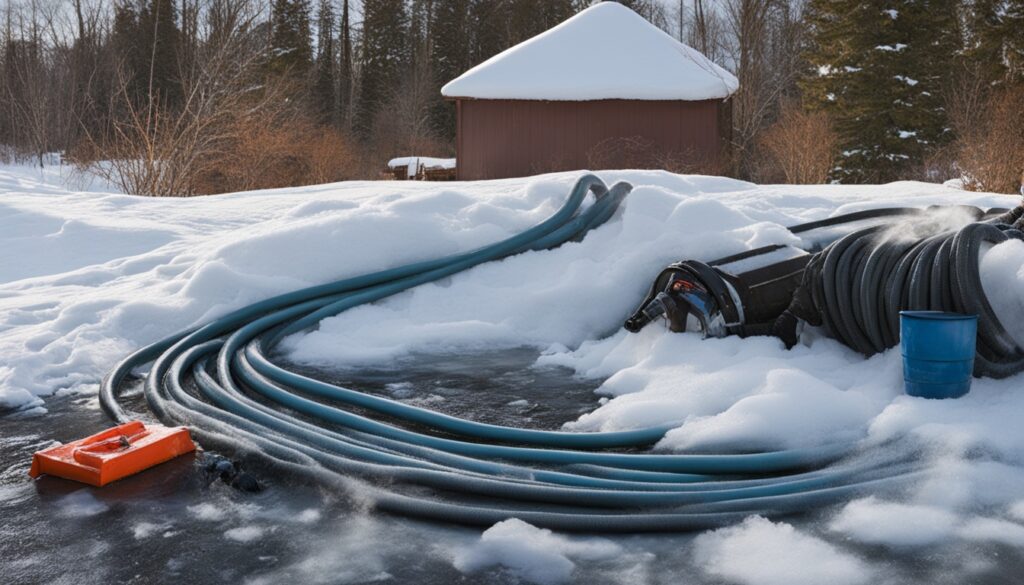
Soaker hoses are efficient and easy to maintain in your garden. By winterizing soaker hoses and leaving them in the ground, you make your irrigation system last longer. This ensures a smooth start to the next growing season.
Disconnecting and Draining Hoses
As winter comes, it’s key to get your garden hoses ready for storage. Leaving hoses outside can cause them to freeze and harm your plumbing. So, make sure to disconnect garden hoses for winter and drain garden hoses for storage.
Start by taking your hoses off any outdoor faucets or spigots. This stops water from freezing in the hose and causing damage. After removing, hold one end up to let gravity drain the water out. This draining process makes sure your hoses are prepared for winter storage.
Once drained, coil your hose and put it in a dry spot like a shed or garage. Keep it there until spring. This proper storage keeps your hoses in good shape for your gardening projects next year.
Hydroponic systems are another way to garden without soil. They offer many benefits.
By disconnecting, draining, and storing your hoses right, you protect your investment. This saves you time, money, and trouble later on.
what vegetables can be grown hydroponically
Hydroponic gardening lets you grow many fresh vegetables at home, even in small spaces. You can grow lettuce, kale, spinach, tomatoes, peppers, herbs, and strawberries easily.
These plants love the controlled environment and nutrient-rich water in hydroponics. This makes them grow well all year. Leafy greens do especially well in hydroponics, giving you more produce than traditional gardens.
Other great options include cucumbers, microgreens, and herbs like basil, cilantro, and parsley. But, root vegetables and larger vegetables might not do as well indoors and are better for outdoor gardens.
When picking what to grow, think about what each plant needs. For example, lettuce likes an EC level of 0.8-1.2, while tomatoes and peppers do best at 2.0-5.0. Keeping the right conditions for each plant is crucial for a good harvest.
Hydroponic gardening is a great way to grow food that’s fresh and chemical-free all year. It’s perfect for city folks and home gardeners looking for a green solution.
| Vegetable | Optimal pH Range | Optimal EC Range |
|---|---|---|
| Lettuce | 6.0 – 6.7 | 0.8 – 1.2 |
| Tomatoes | 5.5 – 6.5 | 2.0 – 5.0 |
| Bell Peppers | 6.0 – 6.7 | 1.8 – 2.8 |
| Swiss Chard | 6.0 – 6.5 | 1.8 – 2.3 |
| Watermelon | 5.8 | 1.5 – 2.4 |
For new hydroponic gardeners, romaine lettuce, butterhead lettuce, and basil are great choices. They grow well and produce a lot in these systems.
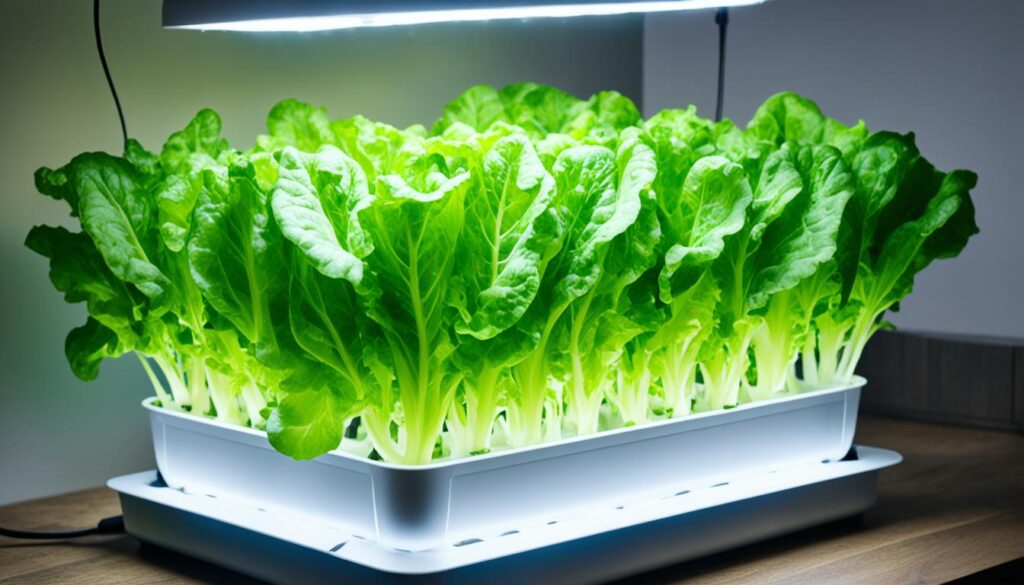
“Hydroponic gardening allows you to grow a variety of fresh produce year-round, even in limited indoor spaces. The controlled environment and nutrient-rich water create an ideal growing medium for many popular vegetables.”
Conclusion
Keeping your garden hoses safe from freezing in winter is key to avoid expensive repairs and replacements. By using garden hose winter care tips, you can keep your outdoor plumbing safe. Consider heated hoses, insulation, and tools like the Freeze Miser to stop hoses from freezing.
Hydroponic vegetable gardening is also a great way to grow fresh food all year, no matter the weather. These systems use much less water than traditional gardens, which is great for areas with little water. You can grow over 25 pounds of food every 28 days indoors, ensuring a steady supply of healthy, chemical-free veggies and herbs.
Whether you’re looking to protect your hoses or start hydroponic gardening, being proactive and using new tech can make your outdoor and indoor gardens thrive. This way, you can enjoy a beautiful garden and a full harvest all year.
FAQ
What happens when garden hoses freeze?
Freezing water inside the hose makes it expand. This can cause the hose to split, crack, or burst. Such damage makes the hose leak and weakens it.
What are the signs that a garden hose has frozen?
A frozen hose is stiff and won’t bend. You’ll also see ice along its length.
Why is it not advisable to leave garden hoses outside during the winter?
Leaving water in the hose can freeze and split it. This means you’ll need to replace it soon.
What are some options to prevent garden hoses from freezing in the winter?
You can use heated hoses, wrap them with heating cables, or insulate them with foam.
How does the Freeze Miser solution work to protect garden hoses?
The Freeze Miser drips water to prevent freezing when it gets cold. It stops when it warms up again.
How should you store garden hoses for the winter?
Take the hose off the faucet, drain it, and coil it into a circle. Keep it in a dry place like a shed or garage.
How do you winterize soaker hoses?
Don’t take soaker hoses apart or drain them. Leave them in the ground, covered with soil or mulch. This keeps them from freezing.
What vegetables can be grown hydroponically?
Great hydroponic veggies include lettuce, kale, spinach, tomatoes, peppers, herbs, microgreens, and strawberries.

